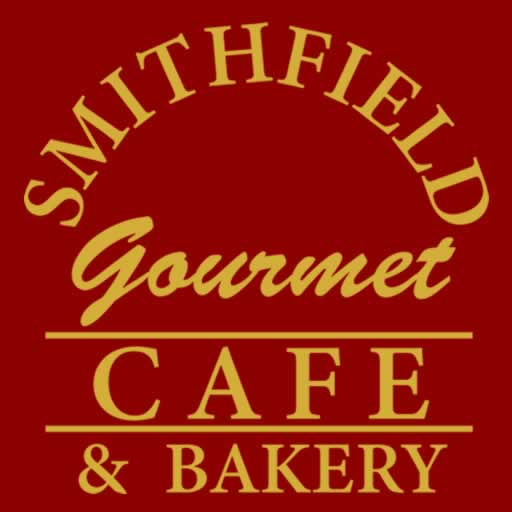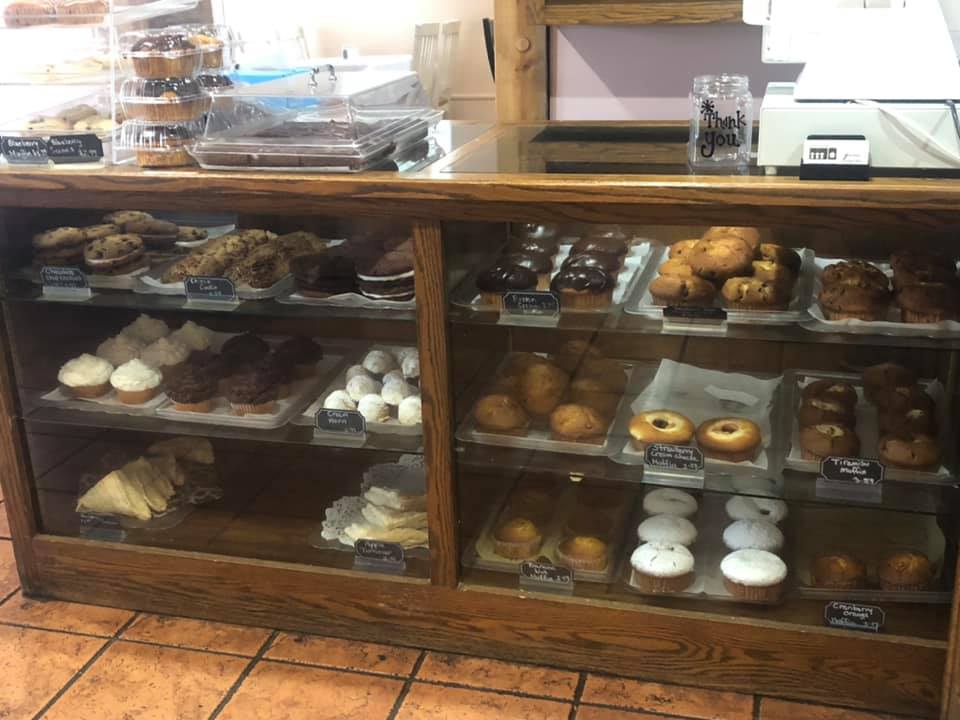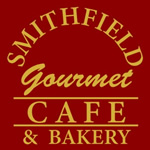Since the Spring of 1993, Smithfield Gourmet Bakery & Café has been making history as Smithfield, Virginia’s quaint gourmet cafe with the fresh, preservative-free food and the charming atmosphere.
We are proud of our commitment to good food and good service. Only freshest ingredients and hand-selected seasonal produce are served here.
Our breads, cakes, and pastries are baked daily, using our own recipes and are created right here on the premises. We invite you to come in and enjoy our fantastic food and service, and then enjoy a leisurely tour of beautiful, historic Smithfield.
We’re honored to have operated this landmark bakery and cafe for more than 25 years. We hope you’ll notice how much time and treasure has been devoted to the preservation of this historic site — for you, and for the future of Smithfield.
On the ground floor, you’ll find our main dining, baking, and kitchen areas, the bustling heart of our historic building.
The third floor is the perfect space for intimate gatherings, fully restored with original pine floors, exposed brick walls, and original windows. Dine lavishly and enjoy special events as they sparkle the night on Smithfield’s romantic Main Street below.
History behind every corner
The architectural home of the Smithfield Gourmet Bakery & Cafe is a National Historic Landmark with hundreds of years and three wars in its past. And also, some say, a host of ghosts.
Discovered by John Smith and first colonized in 1634, a settlement grew in Warraskoyack Shire on the banks of the Pagan River, opposite of the James River shore across from Jamestown. Unable to spell or pronounced the name, (War-a-SKOY-ack), the English settlers promptly changed the name to “Isle of Wight” in 1637.
That same year, the first European settler to own land in the county, Arthur Smith, patented 1,450 acres. It is this Smith Family — and not Capt. John Smith — for whom Smithfield is named.
In 1750, the Commonwealth General Assembly granted permission to Arthur Smith’s heir, Arthur Smith IV, to layout a section of his family estate for sale and the new Town of Smithfield was incorporated by Smith IV in 1752,
The 72 lots and 4 streets of Smithfield were sold to British merchants and ship captains by 1773[1]From www.GenuineSmithfieldVa.com for four pounds, six pence (about $450 in today’s USDs) each [2]National Currency Converter– an expensive purchase for most people at that time! During the 18th Century, wages could be as low as two or three pounds per year for a domestic servant, plus food, lodging and clothing. [3]Old Bailey Online — Wages
Despite the price, Smithfield thrived as a river port and a British colony for 20 years before the Declaration of Independence was signed in 1776. [4]www.Smithfieldva.gov
After the Revolutionary War, Smithfield enjoyed a time of peace, growth and prosperity.
With the start of the War of 1812, Americans in Smithfield again found themselves defending their lands from the British.
In 1813, the British left Hampton after a cruel and ugly siege against U.S. troops and citizens in Hampton, and made their way by water from Black Beard’s Point to Smithfield, 35 miles south. By the time the British arrived, the people of the Town of Smithfield stood ready.
In a report to the Governor of Virginia dated July 28, 1813, Maj. Stapleton Crutchfield wrote of the British attempt to land at Smithfield on the Pagan River:
“Amidst this scene of momentary contusion, the spirit of the citizen was seen arising like the sun amidst the clouds. Every man flew to the public square with his arms — old men of 60 were seen stepping into the ranks: all classes sought the scene of duty — and in one hour from the signal of alarm, the regiment was displayed on the square, in more fordable numbers than it was ever known to exhibit. Exempts of all descriptions, strangers, officers and soldiers of the U. States expressed but one resolution, that was to sacrifice their lives, rather than yield up the metropolis of the state to the invader.” [5]Alexandria Herald, Volume 3, Number 304, 5 July 1813
Jack Blair and Lots 10 & 11
Jack Blair, one of the area’s first freed slaves, built the building now occupied by The Smithfield Gourmet Cafe and Bakery on original Lot 10 in 1815. He expanded it into Lot 11[6]Smithfield Times, Volume 45, Number 36, 3 September 1964, page two, and used it as a brick storehouse for more than 20 years.
At some time in the forgotten past in this location, black pepper was ground in untold measure here, likely for seasoning hams that have been produced in Smithfield since 1787. To this day, ground black pepper can be found under the building. Achoo!
The enterprising and scandalous Blair is credited with bringing water to the town. Legend has it that, in addition to the ground pepper, there is a whale buried beneath building. Peppered Whale, however, is not now (nor has it ever been) on the menu at the Smithfield Gourmet Bakery & Cafe.
Said to be the son of an enslaved woman and a white man, Blair had blond hair and blue eyes. He was prosperous in Smithfield for several years, until his rivalry with business owner Benjamin Drew ruined them both. The two competed to monopolize the community trade until both their finances crumbled. Drew sold out and managed to keep his standing and good reputation until his death at 89 years.
Blair, who at his financial peak owned three sailing vessels, a thriving business and a good amount of town property, left town without notice in 1824, taking with him his 14-year-old son, John. His wordly goods were sold at public auction, and history shows nothing more of his wife Catherine. It was rumored that he fled to New Orleans due to a delicate domestic matter, but that has never been substantiated.
Ownership changes
When Blair owned Lots 10 and 11, there was a brick building on each lot with an unfinished room in between. After Blair defaulted and left town, the lots reverted to Thomas Purdie, who sold the whole property with a residence and two storefronts to James Chalmers, “a most reliable merchant.” Chalmers, however, did not occupy these premises until 1840. The properties were owned by James Chalmers until his death in 1846, and in 1850 the part that was a drugstore was sold to Charles Benham Hayden. Hayden’s father-in-law, Sampson White, operated a general store in that location until the start of the Civil War. Hayden used the unfinished room as his office, as did Thomas Purdie, before him.[7]Smithfield Times, Volume 45, Number 36 — 3 sept 1964
In the meantime, it was occupied by the Rev. William McKenney, a community Methodist preacher who was also engaged in the sale of general merchandise on a large scale. He was a brother of Col. Thomas McKenney, for years a distinguished Indian agent for the United States.
William McKenney was reported to be remarkable for his business talents and pulpit eloquence, preaching on Thursday night of each week. Purdie said, “I was a frequent attendant on those services, attracted by his interesting exposition of spiritual texts. Never have I heard moral and religious subjects treated in a more interesting manner. It was a general subject of astonishment that any man could speak weekly on connotative questions with so much originality and freshness.”[8]Smithfield Times, Volume 45, Number 36 — 3 sept 1964
The store at Lot 10 was next occupied by R.L. Thomas and Robert M. Boykin, merchants and partners, and the interior was altered and the exterior was improved for them.
After 1840, the storehouse and dwelling were the place of business and the residence of James Chalmers until his death in 1846. His daughter-in-law, Belvidera E.P. Chalmers, widow of A. Emmett Chalmers, lived there until she died in 1854. Shortly thereafter, Samuel Boykin, who already owned the storehouse on the west side of the lot, bought the residence.
Young Samuel, said to be “economical, sharp and attentive to his dutie,” had worked for several years in Chalmers’ store. When Chalmers died, Boykin opened a small store. His business prospered and he bought the rest of the Chalmers’ property in 1851.
In 1870, the building opened as C.C. Chalmers & Sons Drugstore, the first of 100 years of pharmacies to operate in this location. [9]from Photo and Photo caption, Smithfield Times, Vol 65, number 8, 22 Feb 1984
The pharmacy got a face-lift in 1897. Druggists’ Circular and Chemical Gazette, Volume 41 — 1897, said “One of the handsomest drugstores in Virginia has been opened by C.C. Chalmers & Sons at Smithfield. The large building has been completely remodeled, and the interior presents a rich effect, the fixtures being made of quartered oak, and resting on a handsome ceramic mosaic floor. The work was done by Reinle Bros. & Salmon, who furnished the fixtures and attended to the general decoration.” [10]Druggists’ Circular and Chemical Gazette, July 1897, page xxii
Since then, the building has served the community by housing various types of businesses.
Smithfield Gourmet Bakery opens in 1993
The Smithfield Gourmet Bakery & Cafe opened in this location on Main Street in 1993, starting a new tradition of delicious, gourmet foods and southern hospitality in this spot. Blair’s erstwhile brick storehouses and the dwelling have been restored to their glory days. Patrons may choose to dine in our main floor dining room or outside in the open air along picturesque Hayden’s Lane. The third-floor residence, now restored to splendor, is available for private events.
While you’re here, ask to see some of the unearthed finds from the building’s past, including items personally handled by the pioneering former-slave, Jack Blair. And, if you see a ghost, say “Huzzah!”
References










